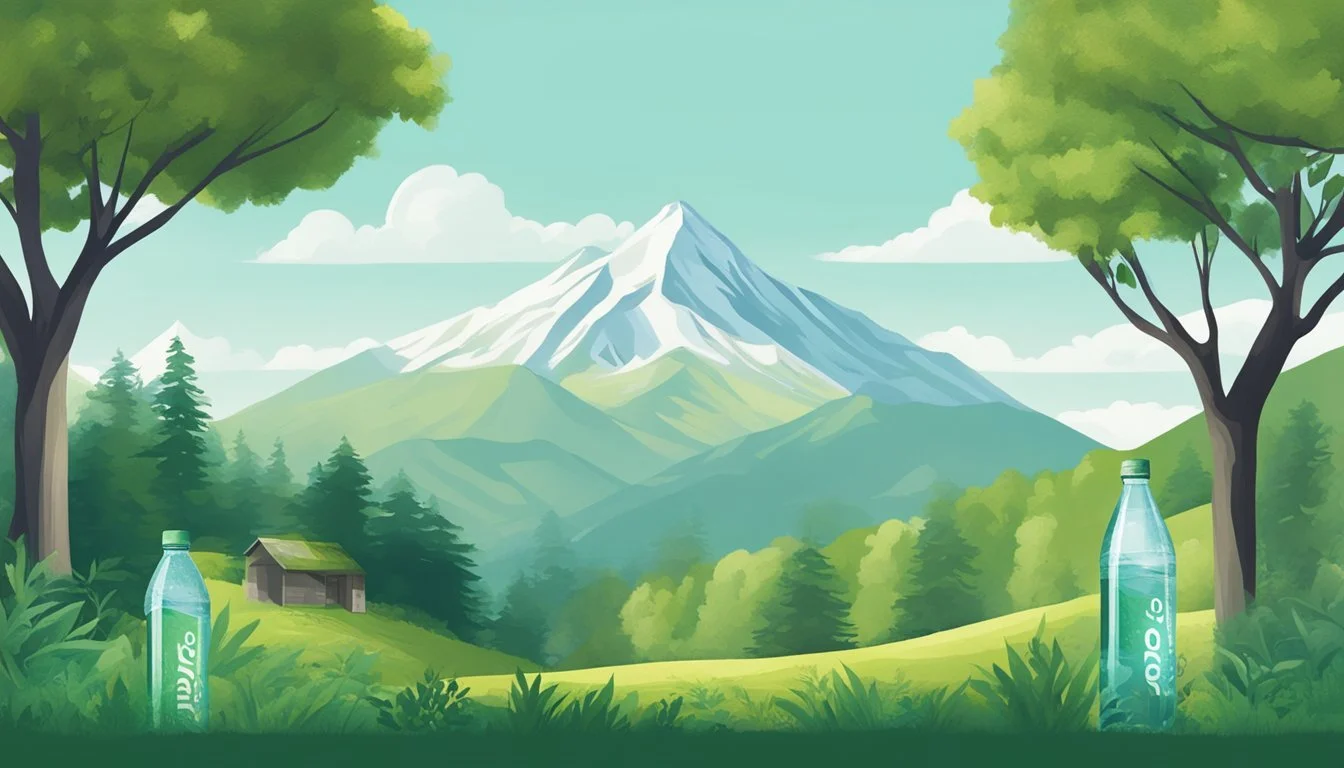Mountain Valley Spring Water vs. Aqua Carpatica
A Comparative Analysis
When choosing between Mountain Valley Spring Water and Aqua Carpatica, discerning consumers often weigh factors such as taste, mineral content, and health benefits. Mountain Valley Spring Water, sourced from Arkansas, is celebrated for its clean, light taste and velvety texture. It has a pH range aligning closely with the body's natural balance, making it a top choice for those prioritizing health and hydration.
In contrast, Aqua Carpatica, which flows from the pristine Carpathian Mountains, is known for its smooth, slightly sweet taste. With a nitrate-free profile and a unique mix of naturally occurring electrolytes, Aqua Carpatica stands out to health-conscious individuals seeking purity.
Both brands offer distinct advantages to bottled water enthusiasts, combining premium taste with notable health benefits. The choice between Mountain Valley and Aqua Carpatica ultimately depends on personal preference for flavor and specific hydration needs.
Origin and Source
This section focuses on where Mountain Valley Spring Water and Aqua Carpatica originate from, detailing their sources and how these influence their quality and characteristics.
Mountain Valley Spring Water Source
Mountain Valley Spring Water is sourced from a natural spring in the Ouachita Mountains of Arkansas. The water emerges from deep within the mountains, passing through layers of limestone and other natural minerals.
This natural filtration process enhances both its purity and mineral content.
The company prides itself on using a single-source origin, ensuring that the spring water is consistent in taste and quality. The water is bottled at the source, preserving its inherent qualities. The Environmental Protection Agency (EPA) regulates the spring, ensuring it meets stringent standards for purity and safety.
Aqua Carpatica Source
Aqua Carpatica comes from the Carpathian Mountains, specifically from natural springs found in the region. These springs are known for their high levels of purity due to the natural volcanic rock filtration process.
This unique geological feature helps to maintain the water’s clean and mineral-rich profile.
The Carpathian region is heavily protected to preserve the pristine condition of the springs. Aqua Carpatica's source, being remote and less industrialized, contributes to its reputation for pure spring water. The water is bottled directly at the springs, which helps maintain its fresh and natural taste.
By focusing on these specific details, the origins and sources of both brands highlight the unique qualities and rigorous standards that define their bottled waters.
Mineral Content and Health Benefits
Mountain Valley Spring Water and Aqua Carpatica are renowned for their unique mineral compositions. This section delves into the specifics of the mineral content and the associated health benefits of each brand.
Minerals in Mountain Valley Spring Water
Mountain Valley Spring Water is celebrated for its rich mineral profile. It contains calcium (67 mg/L), which supports bone health. The magnesium content stands at 7.1 mg/L, aiding muscle function and reducing fatigue. Additionally, the water includes 1.3 mg/L of potassium, which helps regulate blood pressure and fluid balance.
This water is naturally alkaline, enhancing its ability to neutralize body acidity. Trace minerals and electrolytes present contribute to overall wellness, supporting various bodily functions including nerve transmission and muscle contractions. Mountain Valley Spring Water's mineral composition promotes hydration, making it a desirable choice for those seeking a health-conscious option.
Minerals in Aqua Carpatica
Aqua Carpatica is mineral-rich, particularly noted for its calcium and magnesium levels, essential for bone and cardiovascular health. The low sodium content makes it suitable for those on a low-sodium diet. Potassium is another significant component, vital for heart and muscle function.
This water is slightly alkaline, helping to balance body pH levels. The presence of trace minerals such as zinc and silica further enhances its health benefits. The balance of electrolytes in Aqua Carpatica supports hydration and physical performance, appealing to athletes and health enthusiasts alike.
Both Mountain Valley Spring Water and Aqua Carpatica offer a robust mineral profile, each with distinct benefits catering to different health needs.
Taste Profile
Mountain Valley Spring Water and Aqua Carpatica offer distinct taste experiences, reflecting their unique sources and mineral compositions. Each brand appeals to different preferences in the bottled water market.
Tasting Notes Mountain Valley
Mountain Valley Spring Water is sourced from the Ouachita Mountains in the United States. Taste-wise, it features a clean, crisp profile that many describe as refreshing.
The mineral composition enriches the water with subtle, yet noticeable earthy and mineral undertones. This complexity provides a smooth and pleasant mouthfeel appreciated by water enthusiasts. The pH level of 7.3 to 7.7, close to neutral, accounts for its balanced taste, aligning well with the body’s natural pH.
Judges at various water tastings often highlight its refreshment quality, making it a top choice for a satisfying hydration experience.
Physical and Chemical Properties
Mountain Valley Spring Water and Aqua Carpatica are both renowned for their distinctive physical and chemical properties. This section explores the pH levels and total dissolved solids (TDS) of these two premium bottled water brands.
pH Level Comparison
Mountain Valley Spring Water has a pH level that ranges from 7.3 to 7.7. This range is close to the body's natural pH balance, making it slightly alkaline. Its naturally alkaline nature can be appealing to those looking for water that supports bodily equilibrium.
Aqua Carpatica, sourced from the Carpathian Mountains, also highlights its alkaline properties. It boasts a pH level of about 7.8, which is marginally higher than Mountain Valley. The slightly alkaline pH is due to its natural spring origins, providing a refreshingly crisp taste.
Both brands offer waters that can be classified as slightly alkaline, beneficial for hydration without significant acidity or harshness.
Total Dissolved Solids
Total Dissolved Solids (TDS) indicate the concentration of dissolved minerals in water, affecting its taste and mouthfeel. Mountain Valley Spring Water has a TDS level between 100-120 ppm. This moderate mineral content enhances its clean and smooth flavor profile, making it a favorite among bottled water connoisseurs.
Aqua Carpatica reports a TDS level of around 250 ppm. This higher mineral content results from its deep artesian well sources in the Carpathian Mountains. The elevated TDS contributes to a richer taste, with noticeable mineral notes that aficionados might prefer.
The differences in TDS between Mountain Valley and Aqua Carpatica cater to varying taste preferences, offering either a lighter or more mineral-rich drinking experience.
Packaging and Sustainability
In evaluating the packaging and sustainability of Mountain Valley Spring Water and Aqua Carpatica, it's essential to focus on their choice of materials and the environmental implications of these choices.
Bottle Materials and Recycling
Mountain Valley Spring Water primarily uses glass bottles. These are 100% recyclable and reusable, making them a sustainable choice. The brand emphasizes the quality and integrity of its mineral-rich water, and glass helps preserve this.
Aqua Carpatica offers its water in plastic, aluminum, and glass bottles. The plastic bottles they use are recyclable but have a higher environmental footprint compared to glass. Meanwhile, aluminum bottles are another option they provide, which are also 100% recyclable.
Reusable glass bottles are environmentally friendly as they reduce the demand for single-use plastics and other materials that require significant resources for production and recycling.
Environmental Impact
Mountain Valley Spring Water is known for its commitment to sustainability. By using glass bottles, the brand limits its environmental impact. However, the production and transportation of glass bottles are energy-intensive due to their weight.
Aqua Carpatica attempts to balance sustainability and practicality with a mix of packaging materials. Their aluminum bottles are lightweight and highly recyclable, leading to potentially lower transportation emissions. Moreover, their initiatives also include reducing the use of plastics and focusing on materials that are easier to recycle.
While both brands strive to minimize their environmental impact, the choice of materials and their recyclability play significant roles in determining their sustainability efforts. Through these decisions, they cater to environmentally conscious consumers who value both quality and sustainability in their bottled water choices.
Safety and Purity Testing
Mountain Valley Spring Water and Aqua Carpatica are held to high standards when it comes to safety and purity.
Both brands are subjected to comprehensive testing for contaminants such as lead, arsenic, and other heavy metals.
Mountain Valley Spring Water emphasizes its natural purification process. Its bottling facilities use ultraviolet (UV) light treatment to ensure the water is free from harmful microorganisms.
Aqua Carpatica, sourced from the Carpathian Mountains, also undergoes rigorous testing. This brand is known for its low nitrate content, a result of its pristine spring sources.
The Food and Drug Administration (FDA) oversees bottled water safety in the United States, ensuring it meets standards equivalent to those set by the Environmental Protection Agency (EPA) for tap water.
Mountain Valley and Aqua Carpatica comply with these regulations, regularly providing detailed reports of their water's composition.
Consumers can access these reports to check for any presence of chemicals or contaminants. Both brands prioritize offering safe drinking water by consistently monitoring and maintaining their quality standards.
While microplastics are a concern for the bottled water industry, detailed testing reports from Mountain Valley and Aqua Carpatica show minimal to no presence of such contaminants, keeping them within the safety thresholds.
Market Availability and Brand Presence
Mountain Valley Spring Water and Aqua Carpatica have distinct market strategies in terms of their availability and brand recognition. Both aim to differentiate themselves in a saturated market dominated by various established water brands.
Retail Accessibility
Mountain Valley Spring Water is widely available across the United States. It can be found in major grocery stores, including Whole Foods and regionally popular chains. The brand's commitment to using glass bottles often appeals to environmentally conscious consumers, adding to its accessibility in eco-friendly shops.
Aqua Carpatica, sourced from the Carpathian Mountains, boasts limited availability in comparison. It is often found in specialty stores and health-focused retailers. Unlike more mainstream brands such as Dasani and Aquafina, Aqua Carpatica is still expanding its presence in North America.
Brand Recognition
Mountain Valley Spring Water enjoys considerable brand recognition. Originating from Arkansas and established in 1871, it is highly regarded for its mineral-rich content. It often ranks favorably in reports and has gained a loyal customer base over the years. Its use of glass packaging further enhances its premium image.
Aqua Carpatica is gradually building its brand in international markets. Known for its naturally sparkling mineral water, it emphasizes purity and health benefits. While not as universally recognized as Evian or Fiji Water, Aqua Carpatica is carving a niche among health-conscious consumers and is gaining traction through targeted marketing and positive reviews.
Comparative Analysis
Examining Mountain Valley Spring Water and Aqua Carpatica involves evaluating their impacts on health and wellness as well as consumer preferences. Each has unique characteristics that can influence one's choice.
Health and Wellness Impact
Mountain Valley Spring Water is renowned for its balanced pH of 7.3 to 7.7, closely aligning with the body's natural pH level. This mineral-rich water enhances hydration and supports overall wellness. It's sourced from Arkansas and is known for having a clean, crisp taste with a slight mineral presence. The minerals present can potentially provide health benefits such as improved bone strength and better digestion.
Aqua Carpatica, originating from the Carpathian Mountains, is marketed for its low sodium content and high natural bicarbonate levels. This makes it suitable for those monitoring sodium intake and seeking to reduce acidity in their diets. The natural purity and lack of contaminants ensure it stands out as one of the best options for health-conscious consumers. Compared to municipal water, Aqua Carpatica offers an added layer of purity without the chlorine or fluoride typically found in tap water.
Consumer Preferences
When it comes to branding and consumer appeal, Mountain Valley has been consistently favored in taste tests, like those conducted by Thrillist, for its clean and slightly sweet flavor. Many consumers also appreciate its historical legacy as one of America’s oldest bottled water brands, which adds to its appeal. The eco-friendly glass bottles also attract environmentally conscious buyers.
Aqua Carpatica appeals to a niche market focused on natural wellness and low mineral content. Its stylish packaging and emphasis on the purity and pristine source of water make it appealing to consumers looking for a premium and health-centric product. Often chosen by those seeking an alternative to reverse osmosis or purified water, it provides a naturally sourced option with minimal processing.
In tables and charts, Aqua Carpatica shows up as a strong contender for low-mineral and sodium-free options, whereas Mountain Valley leads in taste and mineral richness. The best bottled water depends on whether consumers prioritize taste or specific health benefits.
More About Mountain Valley Spring Water
Acqua Panna vs Mountain Valley Spring Water: Which Bottled Water is Better?
Aquafina vs Mountain Valley Spring Water: Which Bottled Water is Better?
Arrowhead vs Mountain Valley Spring Water: Which Bottled Water is Better?
Bai vs Mountain Valley Spring Water: Which Bottled Water is Better?
Boxed Water vs Mountain Valley Spring Water: Which Bottled Water is Better?
Core Hydration vs Mountain Valley Spring Water: Which Bottled Water is Better?
Dasani vs Mountain Valley Spring Water: Which Bottled Water is Better?
Deer Park vs Mountain Valley Spring Water: Which Bottled Water is Better?
Essentia vs Mountain Valley Spring Water: Which Bottled Water is Better?
Eternal vs Mountain Valley Spring Water: Which Bottled Water is Better?
Ethos vs Mountain Valley Spring Water: Which Bottled Water is Better?
Evian vs Mountain Valley Spring Water: Which Bottled Water is Better?
Fiji vs Mountain Valley Spring Water: Which Bottled Water is Better?
Mountain Valley Spring Water vs HFactor: Which Bottled Water is Better?
Ice Mountain vs Mountain Valley Spring Water: Which Bottled Water is Better?
Icelandic Glacial vs Mountain Valley Spring Water: Which Bottled Water is Better?
Just Water vs Mountain Valley Spring Water: Which Bottled Water is Better?
LIFEWTR vs Mountain Valley Spring Water: Which Bottled Water is Better?
Mountain Valley Spring Water vs 1907water: Which Bottled Water is Better?
Mountain Valley Spring Water vs 7-Select: Which Bottled Water is Better?
Mountain Valley Spring Water vs Action: Which Bottled Water is Better?
Mountain Valley Spring Water vs Alkaline88: Which Bottled Water is Better?
Mountain Valley Spring Water vs Antipodes: Which Bottled Water is Better?
Mountain Valley Spring Water vs Augi: Which Bottled Water is Better?
Mountain Valley Spring Water vs Big Chill: Which Bottled Water is Better?
Mountain Valley Spring Water vs Big Win: Which Bottled Water is Better?
Mountain Valley Spring Water vs Blk: Which Bottled Water is Better?
Mountain Valley Spring Water vs BodyArmor: Which Bottled Water is Better?
Mountain Valley Spring Water vs Cascade Mountain: Which Bottled Water is Better?
Mountain Valley Spring Water vs Castle Rock: Which Bottled Water is Better?
Mountain Valley Spring Water vs CBD Living: Which Bottled Water is Better?
Mountain Valley Spring Water vs Cirro: Which Bottled Water is Better?
Mountain Valley Spring Water vs Crystal Geyser: Which Bottled Water is Better?
Mountain Valley Spring Water vs Crystal Lake: Which Bottled Water is Better?
Mountain Valley Spring Water vs Defy: Which Bottled Water is Better?
Mountain Valley Spring Water vs Erewhon: Which Bottled Water is Better?
Mountain Valley Spring Water vs Essence pH10: Which Bottled Water is Better?
Mountain Valley Spring Water vs Flow: Which Bottled Water is Better?
Mountain Valley Spring Water vs Hawaii Volcanic: Which Bottled Water is Better?
Mountain Valley Spring Water vs Hawaiian Springs: Which Bottled Water is Better?
Mountain Valley Spring Water vs Kirkland Signature: Which Bottled Water is Better?
Mountain Valley Spring Water vs Kroger: Which Bottled Water is Better?
Mountain Valley Spring Water vs Liquid Death: Which Bottled Water is Better?
Mountain Valley Spring Water vs Mananalu: Which Bottled Water is Better?
Mountain Valley Spring Water vs Nestle Pure Life: Which Bottled Water is Better?
Mountain Valley Spring Water vs Open Water: Which Bottled Water is Better?
Mountain Valley Spring Water vs Ophora: Which Bottled Water is Better?
Mountain Valley Spring Water vs Origin: Which Bottled Water is Better?
Mountain Valley Spring Water vs Ozarka: Which Bottled Water is Better?
Mountain Valley Spring Water vs Path: Which Bottled Water is Better?
Mountain Valley Spring Water vs Penta: Which Bottled Water is Better?
Mountain Valley Spring Water vs Perrier: Which Bottled Water is Better?
Mountain Valley Spring Water vs Poland Spring: Which Bottled Water is Better?
Mountain Valley Spring Water vs Proud Source: Which Bottled Water is Better?
Mountain Valley Spring Water vs Purely Sedona: Which Bottled Water is Better?
Mountain Valley Spring Water vs Ramona: Which Bottled Water is Better?
Mountain Valley Spring Water vs Refreshe: Which Bottled Water is Better?
Mountain Valley Spring Water vs Richard's Rainwater: Which Bottled Water is Better?
Mountain Valley Spring Water vs San Pellegrino: Which Bottled Water is Better?
Mountain Valley Spring Water vs Simple Truth: Which Bottled Water is Better?
Mountain Valley Spring Water vs Skyra: Which Bottled Water is Better?
Mountain Valley Spring Water vs Smartwater: Which Bottled Water is Better?
Mountain Valley Spring Water vs Solan de Cabras: Which Bottled Water is Better?
Mountain Valley Spring Water vs Starkey: Which Bottled Water is Better?
Mountain Valley Spring Water vs Tahoe: Which Bottled Water is Better?
Mountain Valley Spring Water vs Talking Rain AQA: Which Bottled Water is Better?
Mountain Valley Spring Water vs The Well: Which Bottled Water is Better?
Mountain Valley Spring Water vs Topo Chico: Which Bottled Water is Better?
Mountain Valley Spring Water vs Tru Alka: Which Bottled Water is Better?
Mountain Valley Spring Water vs Volvic: Which Bottled Water is Better?
Mountain Valley Spring Water vs Voss: Which Bottled Water is Better?
Mountain Valley Spring Water vs Waiakea: Which Bottled Water is Better?
Mountain Valley Spring Water vs Weird Water: Which Bottled Water is Better?
Mountain Valley Spring Water vs Whole Foods 365: Which Bottled Water is Better?
Mountain Valley Spring Water vs Zenwtr: Which Bottled Water is Better?
Mountain Valley Spring Water vs Zephyrhills: Which Bottled Water is Better?
More About Aqua Carpatica
Acqua Pana vs Aqua Carpatica: Which Bottled Water is Better?
Aqua Carpatica vs Alkaline88: Which Bottled Water is Better?
Aqua Carpatica vs Cascade Mountain: Which Bottled Water is Better?
Aqua Carpatica vs Castle Rock: Which Bottled Water is Better?
Aqua Carpatica vs CBD Living: Which Bottled Water is Better?
Aqua Carpatica vs Crystal Geyser: Which Bottled Water is Better?
Aqua Carpatica vs Crystal Lake: Which Bottled Water is Better?
Aqua Carpatica vs Essence pH10: Which Bottled Water is Better?
Aqua Carpatica vs Hawaii Volcanic: Which Bottled Water is Better?
Aqua Carpatica vs Hawaiian Springs: Which Bottled Water is Better?
Aqua Carpatica vs Kirkland Signature: Which Bottled Water is Better?
Aqua Carpatica vs Liquid Death: Which Bottled Water is Better?
Aqua Carpatica vs Open Water: Which Bottled Water is Better?
Aqua Carpatica vs Proud Source: Which Bottled Water is Better?
Aqua Carpatica vs Purely Sedona: Which Bottled Water is Better?
Aqua Carpatica vs Richard's Rainwater: Which Bottled Water is Better?
Aqua Carpatica vs Simple Truth: Which Bottled Water is Better?
Aqua Carpatica vs Solan de Cabras: Which Bottled Water is Better?
Aqua Carpatica vs Talking Rain AQA: Which Bottled Water is Better?
Aqua Carpatica vs Weird Water: Which Bottled Water is Better?
Aqua Carpatica vs Whole Foods 365: Which Bottled Water is Better?
Aqua Carpatica vs Whole Foods Italian Still Mineral water: Which Bottled Water is Better?
Boxed Water vs Aqua Carpatica: Which Bottled Water is Better?
Core Hydration vs Aqua Carpatica: Which Bottled Water is Better?
Ice Mountain vs Aqua Carpatica: Which Bottled Water is Better?
Icelandic Glacial vs Aqua Carpatica: Which Bottled Water is Better?
Just Water vs Aqua Carpatica: Which Bottled Water is Better?
Nestle Pure Life vs Aqua Carpatica: Which Bottled Water is Better?
Poland Spring vs Aqua Carpatica: Which Bottled Water is Better?
San Pellegrino vs Aqua Carpatica: Which Bottled Water is Better?
Smartwater vs Aqua Carpatica: Which Bottled Water is Better?
Topo Chico vs Aqua Carpatica: Which Bottled Water is Better?
Zephyrhills vs Aqua Carpatica: Which Bottled Water is Better?








